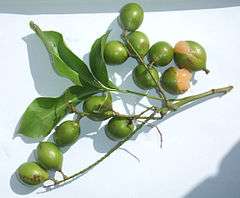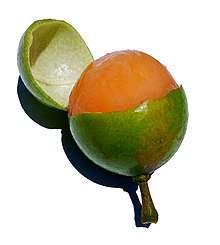Melicoccus bijugatus
Melicoccus bijugatus, genip, guinep, genipe, ginepa, kenèp, quenepa, quenepe, quenette, chenet, talpa jocote, mamón, ackee[1], limoncillo, skinip, kinnip, huaya, or mamoncillo,[2][3][4] is a fruit-bearing tree in the soapberry family Sapindaceae, native or naturalized across the New World tropics including South and Central America, and parts of the Caribbean. Its stone-bearing fruits are edible.
| Melicoccus bijugatus | |
|---|---|
 | |
| Quenepa leaf and fruit | |
| Scientific classification | |
| Kingdom: | Plantae |
| Clade: | Tracheophytes |
| Clade: | Angiosperms |
| Clade: | Eudicots |
| Clade: | Rosids |
| Order: | Sapindales |
| Family: | Sapindaceae |
| Genus: | Melicoccus |
| Species: | M. bijugatus |
| Binomial name | |
| Melicoccus bijugatus | |
| Synonyms | |
Taxonomy
| |||||||||||||||||||||||||||||||||||||||||||||||||||
| Phylogeny of Melicoccus based on morphological traits, showing the placement of M. bijugatus.[5] |
The genus Melicoccus was first described by Patrick Browne, an Irish physician and botanist, in 1756. This description was based on M. bijugatus trees which were cultivated in Puerto Rico. In 1760, Nikolaus Joseph von Jacquin described the first species in Browne's genus, which he named M. bijugatus. In 1762 Linnaeus used a spelling variation of the name Melicocca bijuga. Over the next two centuries, Linnaeus' spelling variation was used in almost all publications. A proposal was made in 1994 to conserve Melicocca over Melicoccus, but the proposal was rejected, leading to a restoration of the original version of the name.[5]
In 1888 German taxonomist Ludwig Radlkofer placed Melicoccus in the tribe Melicocceae together with eight other genera. In his monograph on the Neotropical members of the tribe (Talisia and Melicoccus) Pedro Acevedo-Rodríguez suggested that although Talisia and Melicoccus appeared to form a monophyletic group, the other (Old World) genera probably did not belong to the same lineage.[5]
The specific epithet bijugatus refers to the bijugate leaves,[5] leaves which consist of two pairs of leaflets.
Distribution

_y_Ave._Hostos_(PR-123)%2C_Bo._Playa%2C_Ponce%2C_PR%2C_mirando_al_sureste_(DSC01400).jpg)
Melicoccus bijugatus is native to northern South America and naturalised in coastal and dry forest in Central America, the Caribbean and parts of the Old World tropics.[5] It is believed to have been introduced into the Caribbean in pre-Columbian times and is also found in India.[6] This fruit, known as quenepa in Puerto Rico, grows particularly abundantly in the municipality of Ponce, and there is a yearly celebration in that municipality known as Festival Nacional de la Quenepa (National Genip Fruit Festival).[7] The fruit ripens during the warm summer months.[8][9]
Description
Trees can reach heights of up to 25 m (82 ft) and come with alternate, compound leaves. The leaves have four elliptic leaflets which are 5–12.5 cm (2.0–4.9 in) long and 2.5–5 cm (0.98–1.97 in) wide. They are typically dioecious plants, however polygamous trees occur from time to time. Flowers have four petals and eight stamens and produce void, green drupes which are 2.5–4 cm (0.98–1.57 in) long and 2 cm (0.79 in) wide. Their pulp is orange, salmon or yellowish in color with a somewhat juicy and pasty texture.
Fruit
The fruit is a round drupe, approximately 2–4 cm (0.79–1.57 in) in diameter, with a thin, brittle, green peel. The bulk of the fruit is made up of the one (or, rarely, two) whitish seeds, which are surrounded by an edible, orange, juicy, gelatinous pulp. There are efforts in Puerto Rico and Florida to produce cultivars with a more favourable flesh-to-seed ratio.
When ripe, the fruits have a bittersweet, wine-like flavour and have mild laxative properties. They are extremely rich in iron and phosphorus. The seed, being slippery, is a potential choking hazard.
Fruits mature in the dry season or summer.
Use
The main use of the mamoncillo is its sweet fruits, which are consumed fresh or canned, and can also be used in the preparation of soft drinks and alcoholic beverages. It can produce a strong yellow dye, although it is rarely used for this purpose.
The pit is also edible. When roasted, it resembles cashew nuts. The indigenous peoples of the Orinoco river consume them as a substitute for cassava, and in Nicaragua, they are ground and made into horchata as a cure for parasites.
The wood of the tree is pale, dense and moderately heavy with a fine grain, and is used for construction, carpentry, and fine cabinetmaking. However, it is not particularly durable, so its use is limited to indoors.
The leaves are used in various traditional medicinal preparations, and also used as pest deterrents.
The species is also commonly planted along roadsides as an ornamental tree.[5]
References
- Ackee Tree, Barbados Pocket Guide
- Bailey, L.H.; Bailey, E.Z.; the staff of the Liberty Hyde Bailey Hortorium. 1976. Hortus third: A concise dictionary of plants cultivated in the United States and Canada. Macmillan, New York.
- Janick, Jules; Paull, Robert E., eds. (2008). "The Encyclopedia of Fruit and Nuts". p. 808. Retrieved 13 July 2015.
- Duarte, Odilo; Paull, Robert E. (2015). "Exotic Fruits and Nuts of the New World". ISBN 9781780645056. Retrieved 13 July 2015.
- Acevedo-Rodríguez, Pedro (2003). "Melicocceae (Sapindaceae): Melicoccus and Talisia". Flora Neotropica. 87: 1–178. JSTOR 4393917.
- Francis, John K. Melicoccus bijugatus Jacq. Quenepa. Sapindaceae. Soapberry family (PDF). USDA Forest Service, Southern Forest Experiment Station, Institute of Tropical Forestry SO-ITF-SM; 48.
- Celebra Ponce a su mimada quenepa. Ana María Rolón Romero. La Perla del Sur. Ponce, Puerto Rico. Year 26, Issue 1535. Page 26. 12 August 2009. Retrieved 6 October 2013.
- Entre mañas e infortunios para un dulce desenlace. Daileen Joan Rodríguez. La Perla del Sur. Ponce, Puerto Rico. Year 35, Issue 1755. Page 11. 19–25 July 2017. Accessed 21 July 2017.
- Rinden homenaje a la quenepa en Mercado Urbano de Ponce: La quenepa, un popular fruto de la Región Sur, será la protagonista en esta edición. La Perla del Sur. Ponce, Puerto Rico. (Digital edition only) 21 July 2017. Accessed 21 July 2017.